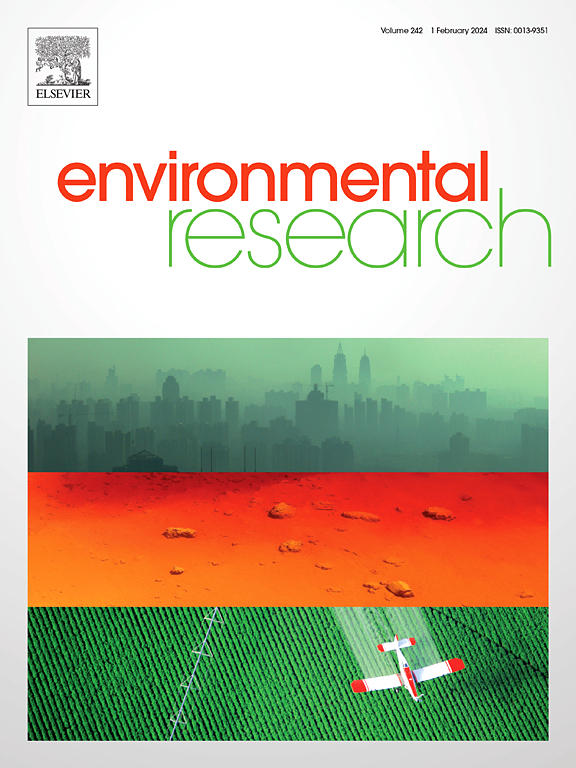用于全氟辛酸(PFOA)有效泡沫分离的两亲性Janus纳米颗粒:改性剂类型的影响
IF 7.7
2区 环境科学与生态学
Q1 ENVIRONMENTAL SCIENCES
引用次数: 0
摘要
全氟辛酸(PFOA)是一种持久性有机污染物,因其对人类健康的有害影响和在水生环境中的普遍存在而日益受到关注。本文介绍了一种新型泡沫分馏方法,该方法使用Janus纳米颗粒作为泡沫稳定剂和捕集剂,有效地去除和富集水中的PFOA。通过全氟烷基硅烷和氨基硅烷的各向异性改性,成功合成了两亲性的Janus-SiO2纳米颗粒(SNPs)。构建的F17-SNPs-N2的两亲性由于高脱离能和桥接机制而增强了泡沫的稳定性。实验分析和DFT计算支持了f17 - snp - n2表面的氟和氨基通过氟-氟相互作用、疏水-疏水相互作用、氢键和静电吸引促进了PFOA的高效吸附。我们还探讨了在不同参数下控制泡沫分馏的机理。在最佳条件下,在180 s的鼓泡时间内,PFOA的去除率和富集率分别达到98%和98%。f17 - snp - n2作为PFOA泡沫分选的双功能材料,即使在存在竞争污染物的情况下也表现出良好的可重复使用性和优异的性能,突出了其广泛的环境应用潜力。本研究为通过后改性设计两亲性janus泡沫分馏剂提供了一种策略,并增强了我们对高效PFOA泡沫分馏背后机制的理解。本文章由计算机程序翻译,如有差异,请以英文原文为准。

Amphiphilic Janus nanoparticles for effective foam fractionation of perfluorooctanoic acid (PFOA): Effect of modifier type
Perfluorooctanoic acid (PFOA), a persistent organic pollutant, is gaining attention for its detrimental effects on human health and ubiquity in aquatic environments. Herein, we introduce a novel foam fractionation method that uses Janus nanoparticles as foam stabilizers and collectors for the efficient removal and enrichment of PFOA from water. The amphiphilic Janus-SiO2 nanoparticles (SNPs) were successfully synthesized through anisotropic modification with perfluoroalkylsilanes and aminosilanes. The amphiphilicity of constructed F17-SNPs-N2 enhanced foam stability due to high detachment energy and a bridging mechanism. The fluorine and amino groups on F17-SNPs-N2 surface facilitated efficient PFOA adsorption via fluorine-fluorine interactions, hydrophobic-hydrophobic interactions, hydrogen bonding, and electrostatic attraction, as supported by experimental analysis and DFT calculation. We also explored the mechanisms governing foam fractionation under different parameters. Under optimal conditions, we achieved PFOA removal efficiencies and enrichment ratios of 98 % and 98, respectively, within a bubbling duration of 180 s. F17-SNPs-N2, as a bifunctional material for PFOA foam fractionation, demonstrated reusability and excellent performance even in the presence of competing contaminants, highlighting its broad environmental application potential. This research provides a strategy for designing amphiphilic Janus-based foam fractionation agents through post-modification and enhances our understanding of the mechanisms behind highly efficient PFOA foam fractionation.
求助全文
通过发布文献求助,成功后即可免费获取论文全文。
去求助
来源期刊

Environmental Research
环境科学-公共卫生、环境卫生与职业卫生
CiteScore
12.60
自引率
8.40%
发文量
2480
审稿时长
4.7 months
期刊介绍:
The Environmental Research journal presents a broad range of interdisciplinary research, focused on addressing worldwide environmental concerns and featuring innovative findings. Our publication strives to explore relevant anthropogenic issues across various environmental sectors, showcasing practical applications in real-life settings.
 求助内容:
求助内容: 应助结果提醒方式:
应助结果提醒方式:


